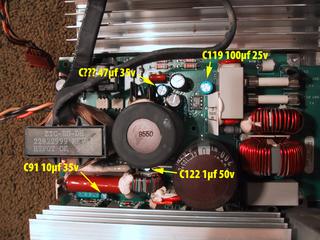
The inside of your powersupply contains lethal voltages which remain deadly long after the unit is disconnected from all external power sources. Do not open your powersupply unless you are experienced with repairing high voltage electronics or have a very strong urge to kill yourself. If you do not take appropriate precautions, such as using appropriate methods to discharge capacitors, YOU WILL DIE.
Every electronic component eventually dies, but the expected lifetime for electrolytic capacitors is quite a bit shorter than most parts you'll find in the average computer. Unfortunatley, these capacitors play a vital role in the functioning of the powersupply of your computer.
Electrolytic capacitors rely on the surface area created between an etched metal electrode and a liquid electrolyte (which forms the other electrode) to function. Unfortunatley, this liquid electrolyte has a nasty habit of evaporating over time, which can range anywhere from 25+ years for a very large/cool capacitor to 5 or fewer years for a small/hot cap.
May also apply to other Indigo2 powersupplies
A common failure mode for this powersupply is for it to randomly switch off the system while in use, often on cool days. The system will fail to respond to any external stimuli except for disconnecting it from the wall for a short period. Alternatley, the system may fail to power up at all, only showing a small twitch on the fans when plugged in, or when the power switch is depressed for the first time after plugging in. This failure mode is most likely due to dead capacitors in the powersupply.
The Indigo2 powersupply is divided into two sections, HV and LV. The HV section contains the main transformer, the HV filter, and the switching circutry. This is where most of the fun happens. The LV side contains the LV filters and supporting logic for controlling and monitoring the powersupply's broader functions.
The HV side is the side of interest for us. It will contain 4 small capacitors that should be replaced, C119 (100µf 25v), C??? (47µf 35v), C122 (1µf 50v) and C91 (10µf 35v). (If you want to cheap out, replacing only C122 and C91 may be enough)
Basically, this is a pretty straightforward component swap. I purchased the replacement capacitors for a whopping grand total of $4.50cdn (be sure to specify 105°c temperature rated capacitors).
Once you've got the powersupply into a somewhat exploded state (note that it's not possible to disconnect the HV board from the LV board - the large conductors leading from the main transformer are soldered in place) and removed the plate from the bottom of the HV board, just desolder the old components, solder in the new ones, clip the leads, reassemble, say a few prayers, grab the fire extinguisher and turn it on.
Don't forget to make a note of which way the capacitors are oriented before soldering them in place. If you get it backwards, you can expect things to explode in a most spectacular way. (The negative side is indicated on the capacitor with a white stripe, and there will be a '+' silkscreened on the board to indicate the proper polarity.)
... is most definitley not guaranteed. :)